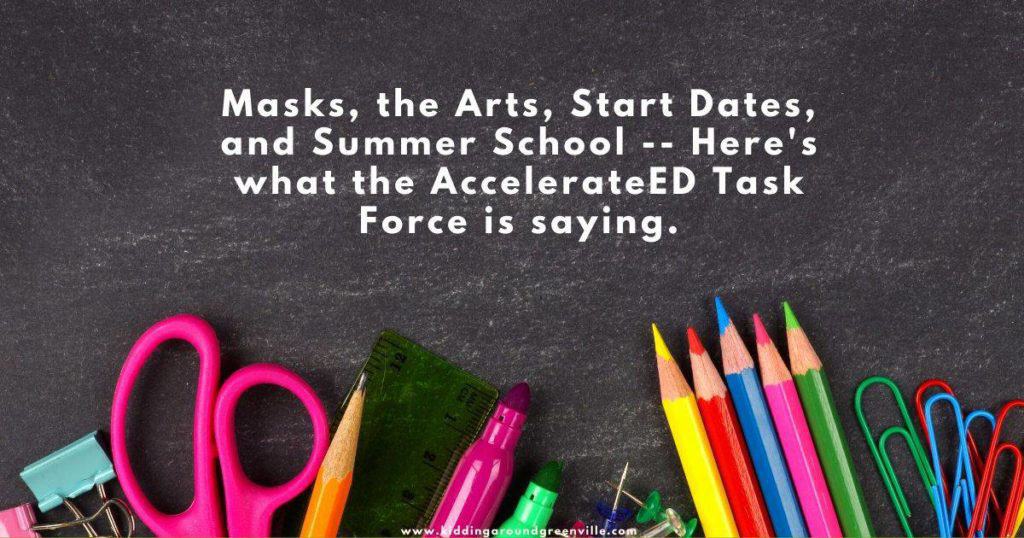Earlier this week, we produced a summary of the DRAFT: AccelerateED Task Force Guidance and Recommendations for the 2020/21 School Year. Today, the Task Force met online to discuss any recommended updates to the draft and to discuss the feedback that they received.
We watched the entire 1 1/2 hour meeting with the goal of telling our readers what was said and what changes have been made to the final draft of the recommendations. You can also watch the meeting on Department of Education website.
Our goal here is to focus on the recommendations most directly related to school beginning in the fall and that were addressed to the public. The meeting also included discussion on state inequities, funding issues, and other public issues that we aren’t able to fully cover here due to length.
I understand that some of the statements here may be controversial. I have tried to keep our coverage limited to quotations and careful summaries without any opinions added. I’m sure it’s not a perfect summary so if you notice something significant that I missed or that should be elaborated on, feel free to leave a comment. I have reordered some of my notes in order to keep the flow of this article easy to follow.
SC AccelerateED Task Force Discussed Topics:
Masks in South Carolina Schools
Recommended Updates to Guidelines, including substitute teachers and the arts
South Carolina Schools Fall 2020 Start Dates and Format

At the Beginning the Task Force Stated:
- The Task Force continually spoke of their respect for the community responses and the many groups that have offered feedback. They reiterated that they read all 600 responses that they received. They thanked the public for being involved and sharing their opinions.
- While our state has been slower to produce a response, part of this is due to transparent online meetings and taking time to get feedback from the community.
- One concern they had heard from the public was the need for more specifics such as what defines low, medium, and high disease spread. They are in constant communication with DHEC and DHEC will provide protocols and thresholds for schools.
On Masks in School:
“If we want to keep schools open, if we want to get back to a more normal life, we have to maintain social distancing, and we have to wear masks when we are out in public. You will see that DHEC and the Department of Education will set an expectation for mask wearing among school communities. Will it be required for all? No, because there are some folks, some children that should not wear masks, but certainly we need to press on our faculty and our parents that one way to hold on the spread is to wear masks so we are working with DHEC on that language and hope that the public will support us in trying to be as careful as possible by wearing masks.”
Molly Spearman, SC Superintendent of Education
On the Recommended Updates to the Guidelines:
Patrick Kelly noted three observations based on reading the responses from the public (approximately 26 minute mark):
- Priority number one is the safety of children and staff.
- While the task force wants to provide clarity and guidance to districts, there is a wide diversity of resources and facilities across the state in many cases due to inequitable funding across generations. As a result, in order to reach the safest options for every student in every district there needs to be flexibility as all districts do not have the same resources and facilities available.
- These recommendations are guidance documents to districts in the state. The Task Force is not a legislative committee or a government agency. They are offering guidance, recommendations, and best practices that have been informed by incredible educators, parents, and community members across the state. Ultimately the efficacy of this report is incumbent on government officials to follow through on the recommendations and on the public to remain engaged on this process because the recommendations are only as good as the follow through that comes after.
Some of the adjustments to the first draft that were made include: adding specifications of national standards for nurse-to-student ratios, clarifying the need for emergency drills to be reviewed to ensure safety while performing drills, including classroom teachers in communication plans, and recommending that children not lose their spots in magnet programs due to choosing distance learning options.
There were also new recommendations and clarifications added about funding requests, waivers for teacher certification maintenance and accountability testing, and that classroom furniture spacing should be clarified to concern desks and seating not items like file cabinets.
On Start Dates:
One notable change for families (approximately 35 minute mark) was the document will now recommend that school districts, due to the uncertainty of health conditions in August, should use caution and discretion when reviewing their start dates for the school year. Any consideration of moving up start dates should be carefully weighed against the recent spread of COVID-19 in our state. They will also recommend that in the case that the assembly approves the funds for the 5 L.E.A.P. days that school districts and school boards should strongly consider having the first scheduled day of the 180 school days start later than currently scheduled. The reason given was that this would allow the least conflict with existing travel plans.
On Substitutes:
For substitution shortages as the report discouraged “sprinkling” (moving children to other classrooms in the event of a substitute shortage) it was recommended that schools utilize all available staff in the building in order to prevent disruption of teacher planning times.
On Teachers Having to Teach Traditional and Distance Learning:
Guiding Principle #2 was clarified: “Districts should avoid any scheduling scenario where the burden falls on a classroom teacher to simultaneously create and implement traditional and distance learning instruction for students in the same day.”
On the Arts:
New Appendixes will be added to the final version which will include new DHEC guidelines, art instruction recommendations such as choral guidelines, and school library recommendations. It was noted that a lot of the best research for the arts is ongoing and in progress.
The need to not cut the arts and physical education was emphasized and Spearman agreed to their importance to children’s social and emotional well-being. But said she was “shocked” when DHEC cautioned her this week as to choral and band programs and to how quickly one student could infect an entire room of students if they were singing properly.
On School Starting in Fall 2020
Spearman said “my challenge and one of my concerns is because I have been hearing some of the talk, I have been hearing some of the talk from districts who say you know, ‘we’re going to operate as normal just like we did’. No, you can’t do that. You can’t do that. And, while I do have some authority here and you all do too…. Now the next move is down to the district level where district officials, school board members, superintendents, principals have got to take this very seriously and do the best they can with implementing this for their communities.”
On Whether the State Is Preparing for Distance Learning in 2020/21:
There is work on producing more efficient and quality distance learning plan for all. About half of the funding from the CARES Act that the Department of Education receives is being used to support getting ready for distance learning. There is work on making sure all schools have the devices that they need. One major issue that remains and is being worked on is lack of access to broadband internet in the state.
On When Is the Latest We Should Know What Our School’s Plan Is for August:
Schools are recommended to have a decision made by 20 days prior.
On Summer School:
Right now there is a real concern with summer school in regards to the COVID spread. Some of the summer schools may have to meet virtually due to the spike in South Carolina.
“I’ll take this opportunity to say to the public who is on the call right now, if you want to go back to school, if you want to go to football games, if you want to cheer on your team, you need to be wearing a mask when you are out in public. It is one of the few things that we know that is effective and folks are just not doing it like they should and it’s going to cause us not to not be able to implement this plan, so I’m calling on the public to participate and really do the things that we know now, we are learning more and more as we go through this pandemic but wearing a mask is effective and we need to do that. We are calling on those that want to see school start, those that want to go to football games, we got to do our part.”
Molly Spearman, SC Superintendent of Education
On School Waivers:
School Superintendent Molly Spearman emphasized her willingness to be flexible and to approve needed waivers to give our schools the ability to have as much face-to-face time with students as possible.
On the Difficult Decisions Facing the School Districts:
“There is a continuum of opinions and thoughts concerning school and that there are two extremes: those that want us to remain closed and those that want us to be fully open and operational as if nothing has changed.”
There is a “Gordian Knot” that exists: “the question of full face-to-face instruction while DHEC is continuing to say that we need to follow social distancing guidelines in classrooms that do not all have desks but many of them have tables. . . . And also the continuing guidelines of buses operating at 50% capacity. This really places districts in an untenable position. That is the crux of the problem is as we look at those guidelines and we are being asked to return to normal. How does that happen? … Many people feel uncomfortable saying we are going to have fully open, functioning schools when DHEC is saying, and I agree with what they are saying, that we have to maintain social distancing in a classroom and in a school bus.”
“There appears to be some level of disconnect between those wanting all students in school versus the realistic concerns that we are hearing from our teachers and other work groups regarding health risks in their return to school. There is a major disconnect between parents wanting their children in school and realizing or not realizing that we are dealing with employees who may be in high-risk health groups who have valid fears and concerns regarding returning to a classroom or a workspace and being exposed.”
Dr. Scott Turner, Deputy Superintendent Greenville County
Spearman stated in response that DHEC has been the most lenient of any state and has personally even entered school buses to try to come up with scenarios that can seat the most children.
There will be a press conference on Monday at 2:30 pm. An Executive Summary of the guidelines will be produced.







Greenville County does not have enough school busses or bus drivers already. Prior to covid many busses were making double runs from schools. The majority of bus drivers are retirees and at significant risk of covid.